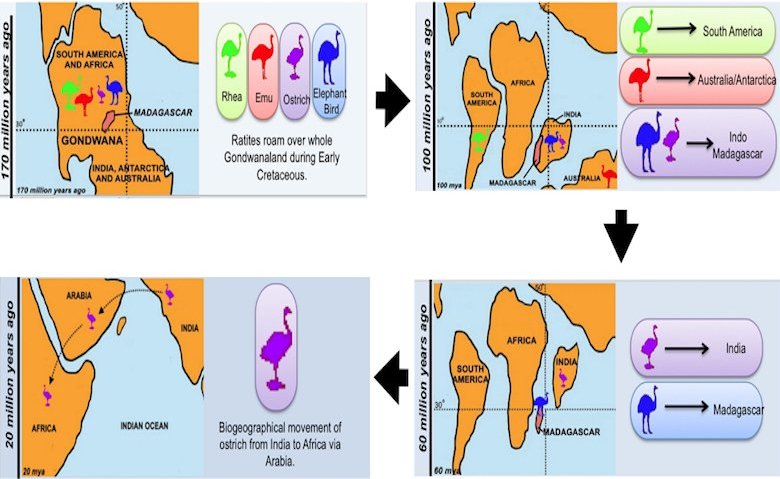
100 million years ago, the splitting of the supercontinent Gondwanaland scattered flightless birds across the landmasses: rheas in South America, emus in Australia-Antarctica and ostriches and elephant birds in Indo-Madagascar. When India later split from Madagascar and slammed into Asia, ostriches hitched along and lived in the sub-continent for a while, before trekking across Eurasia into Africa. Much later, about 60000 years ago, they may have also made their way back to India.
Archaeologists have speculated this much in the past, based on scrutiny of bones and rock drawings. Now, a new study published in PLoS One provides the first genetic evidence for the presence of ostriches in ancient India.
Researchers extracted DNA from fossilised ostrich eggshells dating to the Late Pleistocene — about 25000 – 40000 years ago — and found a 92% match to the current living descendant, the African ostrich. This is the first time that DNA has been extracted from bird eggshell fossils in India, say the authors, adding that the DNA was surprisingly well preserved despite India’s harsh tropical climate.
“It is an important development in our understanding of recent extinctions of large creatures in India and around the world,” says paleobiologist Ashok Sahni, professor emeritus, Panjab University, who was not involved with the research. “The recovery of ancient DNA has exciting possibilities and this study opens a new dimension in this direction.”
Scientists are increasingly looking to sources other than bone and mummified tissue to extract ancient DNA. Researchers at the Murdoch University in Australia recently showed that fossilised eggshells are a richer and hardier source of DNA. “These eggshells have a crystalline matrix which stops the entry of microbes inside,” says Sonal Jain, first author and former PhD student, Department of Biotechnology, IIT Roorkee.
Jain and her colleagues gathered ostrich eggshells from personal collections and excavation sites in Rajasthan and Madhya Pradesh. Then, they reached out to scientists at the Centre for Cellular Molecular Biology (CCMB), Hyderabad, which houses a state-of-the-art ancient DNA lab. “No other lab in South Asia has this facility,” says Kumarasamy Thangaraj, senior principal scientist at CCMB and one of the authors.
The team used advanced microscopy to pinpoint the location of the DNA in the eggshell matrix. With slight modifications to the Australian researchers’ technique, they were able to extract and sequence the eggshell DNA. Working with ancient DNA is challenging. Because samples are rare, every precaution needs to be taken to avoid external DNA contamination, and new DNA sources require modifying existing methods, points out Thangaraj. “It took us 1 – 2 years to optimise the protocol,” says Jain.
Owing to the morphological similarities between late Pleistocene eggshells and those of present-day African ostriches many previous studies have hinted at a “shared ancestry”. But, “eggshell morphologies are not completely reliable for constructing phylogenies (family trees),” says James Blinkhorn, research associate, University of Liverpool. “By demonstrating a shared (genomic) ancestry with modern African ostrich, these results may indicate an expansion of ostrich populations from Africa to India.”
However, clarity on what drove the ostriches to extinction in India after the Pleistocene is still to emerge. “The sudden disappearance of the ostrich remains enigmatic,” says G. L. Badam, retired professor of Palaeontology, Deccan College, Pune. “Possibly, the climatic changes at the end of the Pleistocene may have been one of the several reasons for its extinction.” Other factors may have been human migration into Eurasia or an epidemic, he adds.